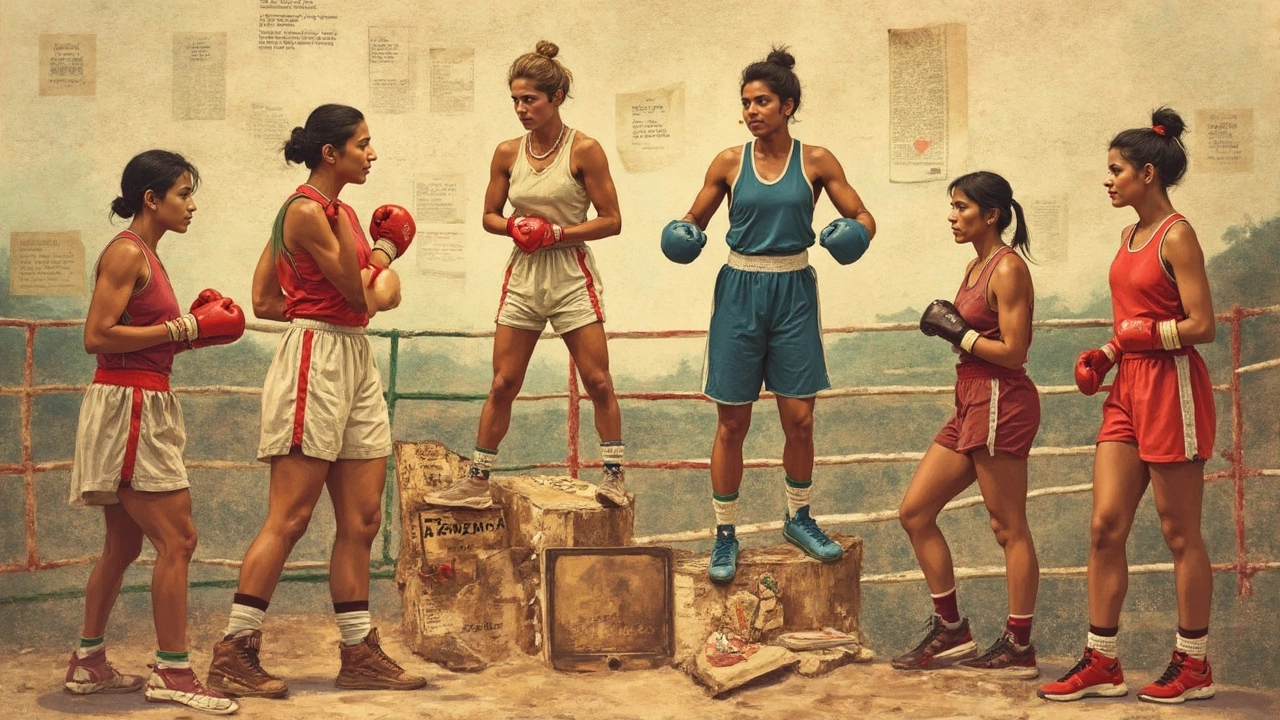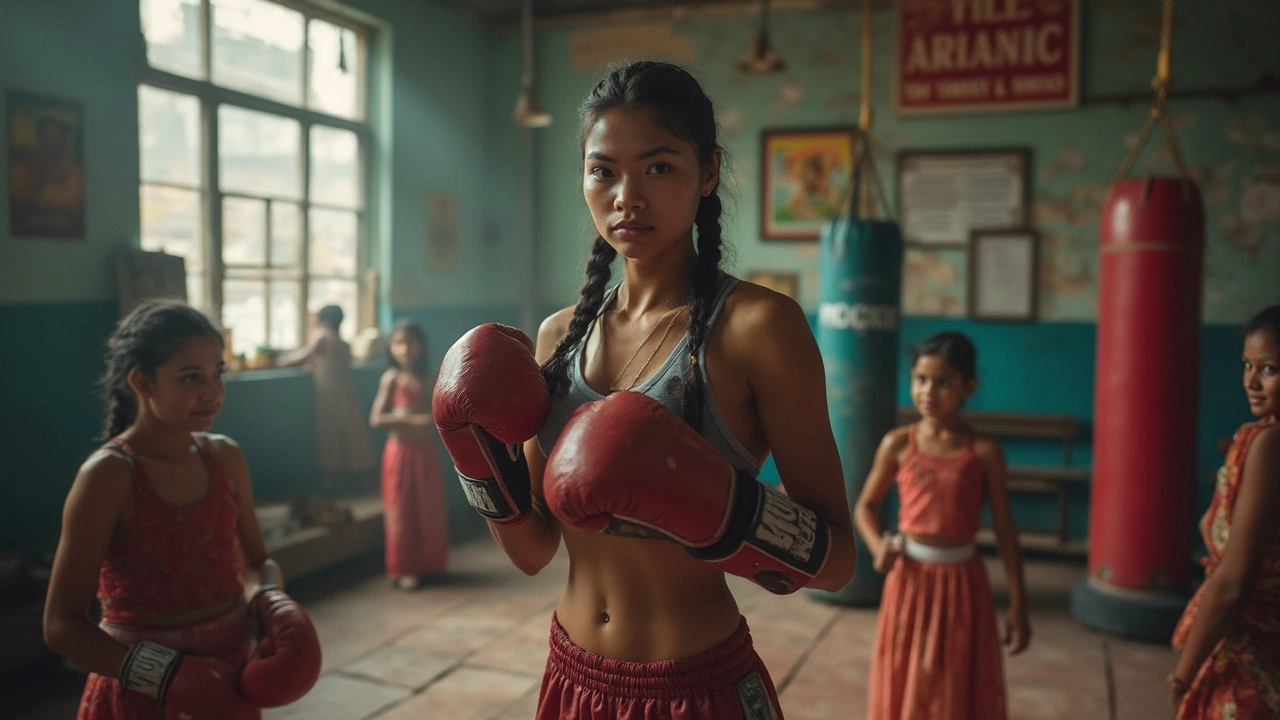You see a woman duck, weave, jab, and land punches with as much thunder as any guy in the ring. But what do you call her? Is she a "boxing girl," a "female boxer," or is there a better term? You might be surprised to know that the world of boxing for women comes loaded with tradition, myths, and even a bit of controversy around names. Why does it matter? Because words hold power, shaping how we see athletes, and even how girls looking up to the ring imagine themselves. There’s a lot behind those gloves—let’s untangle it all.
What Do You Call a Boxing Girl? More Than Just a Name
When someone says "boxing girl," it sounds catchy, but most in the sport simply call her a "boxer" or a "female boxer." Some even call her a "pugilist," if you want to sound old-school. Of course, if you’re talking to her directly, names like "champ" probably feel a lot better than any label. But there’s history behind what we call these athletes. The ancient Greeks actually had female fighters, and so did the Romans—though not always voluntarily. In the modern era, women’s boxing was mostly underground for decades. Promoters didn't see them as "true" boxers. That started changing in the late 20th century, when the term "lady boxer" popped up sometimes, though it felt more patronizing than inspiring. Now, most top athletes and fans just say "boxer," leveling the field.
But does language really matter here? Absolutely. When Olympic boxer Mary Kom from Manipur first hit the news, she was hardly ever called just a "boxer"—mostly "lady boxer" or "boxing girl." That sounds like the sport is just a hobby for her, never mind her world championship medals. The term "boxing girl" still gets used a lot online—search the hashtag and you’ll see thousands of Instagram posts. Yet, in pro settings, the word that sticks is "boxer." If a woman boxes, she's a boxer—same as anyone else who's trained, fought, and earned their corner in the ring. No special tickets needed for gender.
Still, if you admire the cheerful spirit or style of a girl at the gym who's just started learning how to throw a proper right cross, "boxing girl" fits in casual talk. It’s simple, cute, maybe even motivating for some. But in competition, in the news, and in serious conversations, "boxer" is the term that says it all. Watch how rapidly Indian media has shifted from "lady boxer" to just "boxer" after Lovlina Borgohain’s Olympic podium finish in Tokyo 2021. Ask any coach from Delhi’s top clubs, and they’ll tell you the girls in the ring want the same respect and the same title as the boys. No extra words or pink gloves are required—unless that’s their own style.
History of Female Boxers: Struggles & Wins
Women throwing punches isn’t a fad—it’s been happening for centuries, often quietly. The first widely recognized female boxing match took place in London in 1722, between Elizabeth Wilkinson and Hannah Hyfield. The crowd paid money to watch, even though, at the time, boxing was mostly a bare-knuckle, brutal affair with no gloves and little in the way of safety. Still, Wilkinson became one of the earliest names in the sport. But as Victorian-era gender rules tightened, women in Europe and the US got pushed out of the ring. For most of the 19th and early 20th centuries, fights were banned, or only allowed as circus “novelties.”
It wasn’t until the 1970s and 80s that things started changing worldwide. In 1996, the USA legalized amateur women’s boxing—pretty late, right? Sure, there were pioneers before, like Barbara Buttrick in England during the 1950s, but media barely cared. Then came legends like Christy Martin, Laila Ali (yes, Muhammad Ali’s daughter), and India’s very own Mary Kom. Suddenly, "boxing girl" started meaning something powerful, not less.
In India, the real shift started with Mary Kom’s first world title in 2002. Since then, Indian women boxers have won over a dozen world and Olympic medals. Nineteen-year-old Nitu Ghanghas won gold at the 2022 Commonwealth Games and got a huge welcome back home in Haryana—it really makes you think how quickly things can turn from forbidden to celebrated. Now, girls in cities and villages show up to boxing classes with dreams that didn’t exist a generation ago. What used to get judged as "tomboyish" is suddenly cool. All of this explains why the simple shift from "boxing girl" to "boxer" is important; it marks real, lived change.
| Year | Milestone |
|---|---|
| 1722 | First reported women's boxing match (London) |
| 1954 | Barbara Buttrick becomes first woman with a US boxing license |
| 1996 | Women's amateur boxing legalized in the USA |
| 2001 | First AIBA Women's Boxing World Championships |
| 2012 | Women's boxing included in the Olympics (London) |
| 2021 | Lovlina Borgohain wins Olympic bronze for India |
Women’s boxing isn’t stuck in the shadows anymore—today it’s all about equal pay, headline fights, sold-out stadiums, and new role models popping up on social media every day.

Facts and Myths: What Makes a Female Boxer Unique?
Ready for some straight talk? There's a lot of nonsense out there about women in the ring. No, boxing girls don’t have to be aggressive or "masculine" to win. In fact, speed, footwork, and smarts matter way more than sheer power—just ask Nicola Adams, Olympic gold winner from Britain, known more for her technique than her knockout punch. Indian female boxers, including Simranjit Kaur and Sakshi Choudhary, train with the same drills and diets as their male counterparts. The gloves are the same, and so are the rounds in international bouts, though Olympic women's bouts used to be four rounds instead of three—now, it’s equal at three rounds for both men and women.
Here's a cool stat: At Tokyo 2021, 34% of boxing competitors were women, the highest ever for any Olympics at that point. That’s a serious jump from London 2012, when women’s boxing made its Olympic debut. In India, registration for girls at boxing academies has gained like wildfire—national-level tournaments for under-18 girls now see entries from every state. The Indian Boxing Federation reported in 2024 that the number of female registered boxers crossed 15,000, which is huge considering the numbers were barely a few hundred two decades ago.
Don’t buy into the fake stories about female boxers getting "bulky" or losing their "femininity." Training is actually great for fitness, confidence, and mental health. A recent survey published by The Lancet in 2023 showed girls who took up combat sports reported higher rates of self-esteem compared to their peers in other sports like basketball or tennis. The ring teaches discipline and quick thinking—these skills go well beyond sports.
Here are some curious myths, busted:
- "Boxing girls are always tough and unfriendly" – Actually, most are some of the friendliest people you'll meet. They just switch on when the gloves go on.
- "You need massive biceps to land a punch" – Science says technique, timing, and leg power matter way more than arm size.
- "It’s a guy’s sport" – Doesn’t stack up with the numbers or the fans anymore. TV ratings for women’s headline fights, like the 2023 Katie Taylor vs. Chantelle Cameron bout, outdid several men’s bouts in Europe.
- "Women’s matches aren’t as exciting" – If you’ve seen Nikhat Zareen’s aggressive style, you know she brings all the fire, and then some.
What actually makes a female boxer unique is her journey. Many grow up facing more resistance—from family, society, and even trainers. When someone earns her way from the local club in rural Bihar all the way to a national medal, that grit shapes not just an athlete, but a wave of belief for others too.
How to Get Started: Tips for Aspiring Boxing Girls
If you—or someone you know—wants to enter the world of boxing, the road is way more open today than before. The first thing? Don’t worry about being called a "boxing girl" or "female boxer"—focus on learning the ropes. Take these steps if you want to get serious:
- Find a legitimate local gym. Many in Delhi and other big cities offer trial classes, especially for beginners.
- Pick up the basics: stance, movement, jab. Don’t try to skip ahead to big punches—footwork is the secret sauce.
- Sparring isn’t compulsory at the start. Learn pad work and shadow boxing. Only enter the ring when you’re ready, mentally and physically.
- Buy your own gloves and wraps. Hygiene matters, and good gear means fewer injuries.
- Don’t believe everything you see on Instagram reels. Real training is sweaty and sometimes slow, but skill builds over time.
- Balance your routine: boxing uses your legs as much as your fists. Jump rope, sprints, and squats build that strength.
- Connect with coaches who support girls in the ring. Attitude matters as much as skill—find someone who pushes you but respects your boundaries.
If you worry about safety, know this: modern gyms use headgear and mouthguards for all sparring, and coaches watch everything closely. Plus, boxing teaches self-defense like nothing else. Many women start for fitness or confidence, then fall in love with the challenge. Listen to your body, stay consistent, and look up to real-life role models—maybe Mary Kom, Nikhat Zareen, or even someone from your own city. Not every "boxing girl" dreams of medals—sometimes the biggest win is the confidence to walk taller. And as for what to call yourself? You pick the name that fits your mood. As long as you lace up those gloves, step in the ring, and throw a punch that surprises even you, the world will notice—and that’s what really counts.




